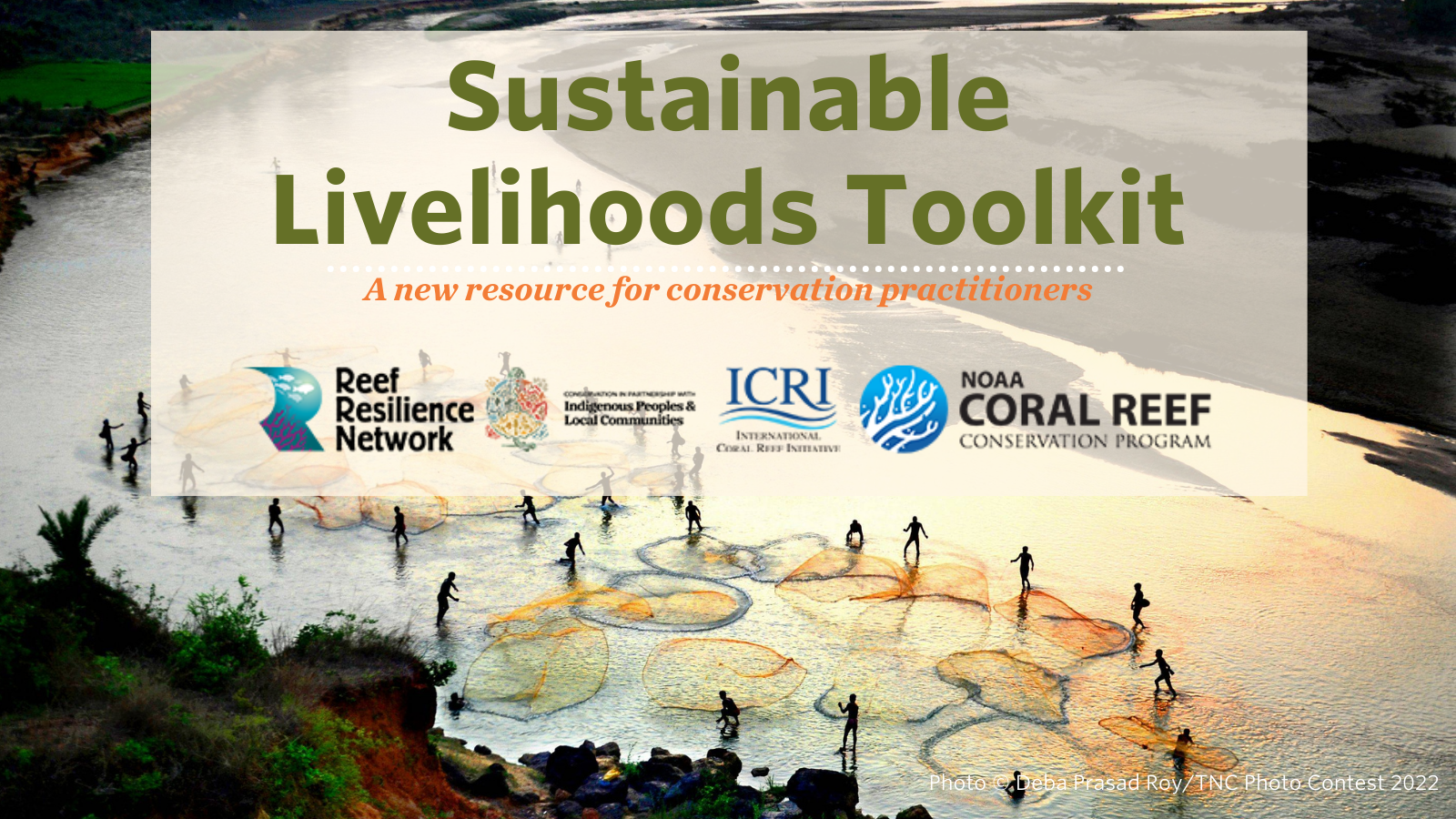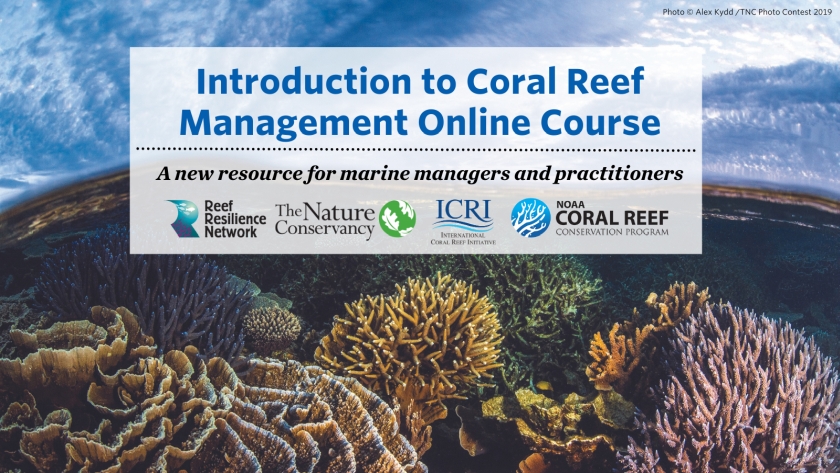PIMPAC Adaptive Management Course for Micronesia: Training Materials
In the winter of 2024, supported by the Pacific Islands Managed and Protected Areas Community (PIMPAC) and the Micronesia Challenge, the Reef Resilience Network and The Nature Conservancy’s Micronesia Program partnered with the Micronesia Conservation Trust to deliver a 5-part online training on "using protected area management effectiveness (PAME) to update management plans" to marine managers in Kosrae, Palau, Pohnpei, the Republic of the Marshall Islands, and Yap.
The objectives of the course were to help participants:
- Understand key components of management effectiveness that should be considered throughout different management stages (e.g., scoping, planning, implementation, learning, adaptive management).
- Adapt management through assessing site management effectiveness, developing a work plan to improve effectiveness, and updating a management plan.
- Gain capacity to lead Protected Area Management Effectiveness (PAME) assessments and adapt management to improve effectiveness in local contexts.
As part of the course, teams reviewed key components of management effectiveness, assessed their site using the Management Effectiveness Tracking Tool (METT-4), and used information discussed throughout the course to support the updating of their sites’ management plans.
The following videos and materials were extracted from this training and are provided here to support future work by protected area managers in Micronesia.
How to Use These Materials
These materials provide information and support for teams who are planning a PAME assessment and/or management plan update. They provide in-depth information on key components that should be considered during assessment and planning activities, as well as a process to improve results of such efforts.
While it is possible to review these materials all at once, it is suggested that you follow the modules below to work your way through them. For each module, we suggest you view the listed video chapters and complete the associated worksheets. The worksheets will help you capture information needed to support your assessment and update your management plan. Instructions are also provided to complete different tabs of the METT spreadsheet that relate to the material covered in the videos.
Please note: the individual video segments are often chapters in larger videos that have been uploaded to YouTube. Please be aware that the videos need not be watched all at once and video chapters may not play in the same order on YouTube as they are listed here. The video links are set up to link directly to the relevant topic; once you have completed viewing the topic, return to this page to continue your progress through each module.
Module One: Adaptive management and PAME Overview
This module introduces the concepts of adaptive management and protected area management effectiveness and how they are linked. It also provides an overview of the METT-4 tool that is used to assess PAME in this course.
- Review all of the Adaptive Management and PAME Overview Videos
- Adaptive Management Review
- Assessing Protected Areas Management Effectiveness (PAME) to Adapt Management
- Protected Area Management Effectiveness Overview
- PAME Globally and Regionally
- Review METT-4 tool videos
- Getting Started with the METT4 Tool (How Do We Assess Management Effectiveness?)
- METT4 Tool Overview
Note: This tool MUST be kept in .xlsx format and used in Microsoft Excel in order to function correctly. It will not work in G-Suite, Open Office, or other spreadsheet software, and even opening it through a different software will cause it to function incorrectly when later opened in Excel.
- Download and complete the Module 1 Worksheet: Preparing Your Team to Assess Management Effectiveness, including the following sections:
- Getting Organized Checklist
- METT-4 “PA Attributes” Tab
- Use your existing Management Plan to help answer questions
- Gather Sources of Information to Understand Progress
Module Two: PAME Components: Local Context
This module introduces key PAME components that should be considered before planning or updating a management plan to understand the local context of the site.
- Review PAME Components Video Chapters 1 – 4
- PAME Components 1: Socio-ecological context
- PAME Components 2: Rights to manage
- PAME Components 3: Political will and support
- PAME Components 4: Nested governance
- Download and complete the Module 2 Worksheet: Assessing Progress toward Plan Objectives, including the following sections:
- Collect Monitoring Results
- Complete METT-4 Tabs: 1, 4, 26, 27
Module Three: PAME Components: Planning Phase
This module introduces key PAME components that should be considered during the planning phase of a protected area.
- Review PAME Components Video Chapters 5 – 8
- PAME Components 5: Management Planning
- A Simple Management Plan Template
- PAME Components 6: Zoning and Rule Development
- PAME Components 7: Climate Change Resilience
- PAME Components 8: Monitoring and Review Periods
- Watch this video about a case study from Liz Terk, Conservation Director, TNC Micronesia about Oneisomw in Micronesia: Designing MPAs to Achieve Community Objectives
- Download and complete Module 3 Worksheet: Threat Assessment & Planning Review, including the following sections:
- Management Plan Component Review – Management Plan Activity
- Update your Conceptual Model or Complete a Threat Assessment
- Download and complete the Module 3 Management Plan Activity
- Complete METT-4 Tabs: 3, 5, 7, 9, 22, 23, 24, 30, 31, 33, 34, 39
- Detailed Assessment of Threats
Module Four: PAME Components: Implementation and Review
This module introduces key PAME components that should be considered during implementation of plan activities as well during periods of review and adaptive management.
- Review PAME Components Videos 9 – 16
- PAME Components 9: Clear Boundaries
- PAME Components 10: Stakeholder Outreach & Engagement
- PAME Components 11: Threat Reduction
- PAME Components 12: The Compliance and Enforcement Chain
- PAME Components 13: Sustainable Tourism
- PAME Components 14: Monitoring Outcomes
- PAME Components 15: Learning and Reviewing
- PAME Components 16: Management Capacity and Sustainable Finance
- Download and complete the Module 4 Worksheet: Completing the METT-4
- Complete METT-4 Tabs: 2, 6, 8, 10, 11, 12, 13, 14, 15, 16, 17, 18, 19, 20, 21, 25, 28, 29, 32, 35, 36, 37, 38
Module Five: Using the METT-4 Tool
This module contains helpful tips on how to use METT-4 tool results to support management plan updates.
- Review the How to Use METT4 Results Video
- Download and complete the Module 5 Worksheet: Learn from Your Assessment and Begin to Update your Plan
- Get ready to work with your community and update your management plan


